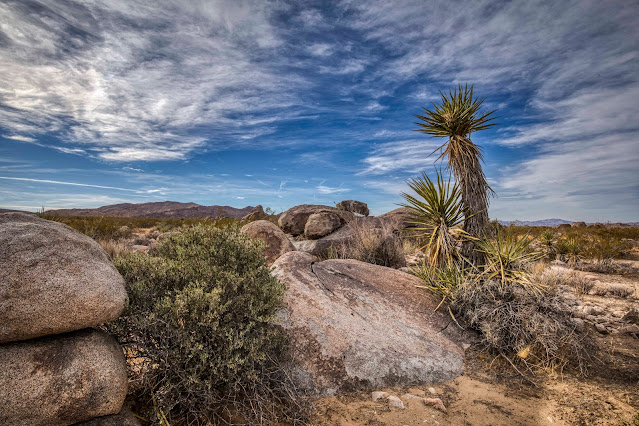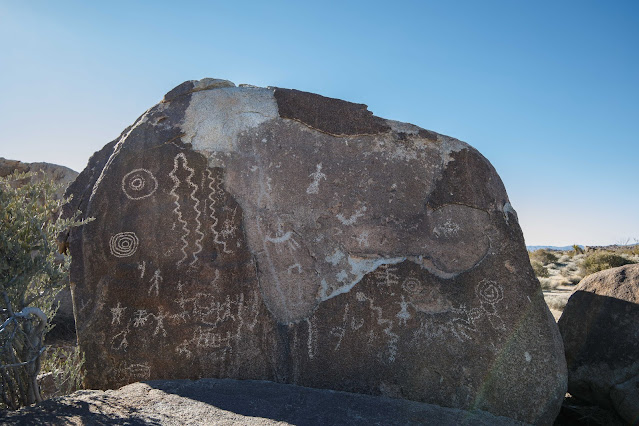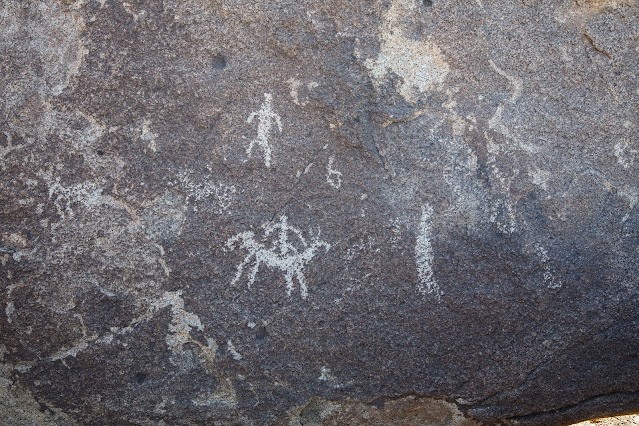So you've never heard of Conejo Well in Joshua Tree National Park? You're not alone. It's kind of an obscure and remote location, with not much remaining to hint at what it once was. But at one time, there was a prospector by the name of Lee Lyons who built himself a sweet little cabin and lived here. There was an active spring, a well, and pipes that brought water to or near the cabin. There was even a "road" of sorts. A beautiful little desert paradise!
This part of the road looks quite passable, but as you follow it straight ahead, things get sketchy. The "road" continues, but see what I mean about sketchy? Can you imagine trying to drive this road to and from your house for food and supplies way back in the 20's or 30's? This area is remote even today. Imagine what it must have been like back then!The best write-up I've seen on Conejo Well is by the DZRT GRLS and can be found here. If you're interested in taking a deeper dive to learn about this area, I highly recommend it!
Just before we head up into the canyon, we come across this clearing site with lots of old stuff. Really interesting old stuff! At first I wondered if this might be the Lee Lyon's cabin site, but I don't think it is.I can imagine these rocks being in the shape of a fire ring 90 or 100 years ago. But it's hard to explain the large amount of cans, glass, and other debris in the area. Perhaps this was where Lee dumped his trash? The old rusty cans are everywhere, even down in the adjacent wash. Someone spent a lot of time here! |
| Biscuits, anyone?? |
Soldered hole and cap cans were in use in the early 1900's, which is consistent with when Lee Lyons would have been living here, doing a little prospecting, and enjoying his desert cabin.Condensed milk must have been a favorite with prospectors, because the cans are commonly found. This can appears to have been opened with a hole punch of some sort.
 |
| Perhaps a coffee can?? |
You could easily explore here for hours and hours looking through all the old rusty stuff. Really interesting, but we need to move on.After following the old "road" that parallels the wash, we come upon this clearing. I'm almost certain this is the site of Lee Lyon's cabin. There's debris in the area, and someone put in a lot of work to clear this spot.More evidence, and you're going to have to trust me on this one. Straight ahead, in that mess of thorny brush, is a large hole. Parts of it even appear to be lined with stone, but it appears to be more rectagular than round. Because of the brush and deep shadows, I couldn't photograph it (that's the trust me part). I'm thinking this is likely Conejo Well. Either a traditional well, or perhaps more of a holding tank for water piped here from the wash. This is very close (just behind) the cleared area that I suspect was the cabin site.Right next to the well site is this pile of stones with a couple of iron bars stuck in the ground. Your guess is as good as mine!More evidence that the cleared area is the former cabin site: Rusty nails everywhere! Which raises an excellent question that I know you are asking: Where is all the wood from the old cabin? Perhaps a cabin fire destroyed it all, but I see no evidence of charred wood, so I doubt it. I'm guessing someone came and carried it off. Bill Keys was a well known scavenger, and his family ranch is filled to the brim with building material, car parts, and anything else he could scavenge. Wood was extremely hard to come by given how remote this area was. If Lee decided his prospecting wasn't paying off and moved on, I'm guessing someone came and helped themselves to the wood used to build his cabin.

Old pipe going up the wash near the cabin site. How far up the wash it goes is hard to say. Parts of the pipe are broken and gone, and parts are under sand and rock, so it's difficult or impossible to follow. During our visit, we could find no standing water. Sections of the wash are heavily overgrown with plants, so it's possible there could be a spring here and we just didn't see it.
It appears that a critter had been digging in the soft sand in the wash, and yes, that's a little pocket of water. Looks like the groundwater here is very close to the surface.Parts of the wash are completely overgrown and impassable. We got about as far as that big juniper bush, rested for a bit, and decided it was time to start the long hike back to the car. It would have been interesting to explore further up the wash, but we just didn't have time.
We spot what looks like a pipe or pole sticking out of the ground up on top of the ridge overlooking the wash. If you look closely, there are actually two poles (one short and one long). That would be a long, difficult climb to get up there, so we will have to save that for another day, but we can't help wondering what it is.
About a mile from the car, we spot this beautiful rosy boa. This is only the second one I've seen in the park, and I think they are pretty rare. We try not to disturb him, take a quick photo, and move on.
As we were finishing up the hike, clouds moved in and the sky became very dramatic. I ended up with a lot of pretty sky shots that I will share with you on a future post.
Thanks for joining me on another adventure to a seldom seen location in JTNP!!




.jpg)

.jpg)













































